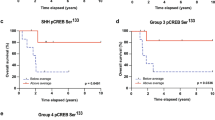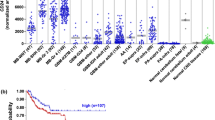Abstract
Medulloblastomas are cerebellar tumors which are primarily composed of sheets of uniform, small malignant cells and may have astrocytic, neuronal or no features typical of these cell types. The assessment of astrocytic differentiation in medulloblastoma rests largely on the detection in malignant cells of glial fibrillary acidic protein (GFAP), a marker present in the later stages of normal astrocyte differentiation. It is still not known whether cells that do not contain GFAP in medulloblastomas with astrocytic differentiation correspond to highly proliferative astrocyte progenitors in maturation arrest at earlier stages of differentiation. The purpose of the current study was to examine whether cells in short term culture derived from a medulloblastoma tumor specimen with astrocytic differentiation were of the astrocytic lineage and if so, whether they represented proliferative astrocyte progenitors which would morphologically and antigenically mature in response to differentiating agents. A portion of tumor specimen from a 10-month-old child with recurrent posterior fossa medulloblastoma (RB2) that contained GFAP focally in tumor cells was grown in monolayer culture. We examined cellular structure and appearance of western immunoblotting and immunohistochemical studies for GFAP and neuron-specific enolase (NSE) in RB2 cells before and after treatment with retinoic acid (RA) and dibutyryl cyclic AMP (dBcAMP). RB2 in culture consisted of small polygonal cells (93%), large flat cells (3%), and polygonal cells with cytoplasmic processes (4%). In untreated RB2, 30% of cells expressed GFAP and staining for NSE was negative. RA treatment produced flattened cells and decreased GFAP. DBcAMP reversibly induced fine cytoplasmic processes containing GFAP in 85% of cells within 96h. Neither agent induced NSE. The results suggest that cultured cells which are derived from a medulloblastoma with astrocytic differentiation do not spontaneously differentiate but that treatment with dBcAMP suppresses proliferation, enhances cytoplasmic process formation and increases cytoplasmic GFAP. Cells in culture and in medulloblastoma tumor specimens which do not contain GFAP may represent astrocyte progenitors in maturation arrest.
Similar content being viewed by others
References
Park TS, Hoffman HJ, Hendrick EB, Humphreys RP, Becker LE: Medulloblastoma: clinical presentation and management. J Neurosurg 58: 543–552, 1983
Allen JC, Bloom J, Ertel I, et al.: Brain tumors in children: current cooperative and institutional chemotherapy trials in newly diagnosed and recurrent disease. Semin Oncol 13: 110–122, 1986
Packer RJ, Sutton LN, Rorke LB, et al.: Prognostic importance of cellular differentiation in medulloblastoma of childhood. J Neurosurg 61: 296–301, 1984
McAllister RM, Isaacs H, Rongey R, et al.: Establishment of a human medulloblastoma cell line. Int J Cancer 20: 206–212, 1987
Friedman HS, Burger PC, Bigner SH, et al.: Establishment and characterizationn of the human medulloblastoma cell line and transplantable xenograft D283 Med. J Neuropathol Exp Neurol 44: 592–605, 1985
Jacobsen PF, Jenkyn DJ, Papadimitriou JM: Establishment of a human medulloblatoma cell line and its heterotrans-plantation into nude mice. J Neuropathol Exp Neurol 44: 472–485, 1985
Rubinstein LJ, Herman MM, Hanberg JW: The relationship between differentiating medulloblastoma and dedifferentiating diffuse cerebellar astrocytoma. Cancer 33: 675–690, 1974
Fedoroff S, Neal J, Opas M, Kalnins VI: Astrocyte cell lineage. III. The morphology of differentiating mouse astrocytes in colony culture. J Neurocytol 13: 1–20, 1984
Berthold F: Current concepts on the biology of neuroblastoma. Blut 50: 65–74, 1985
Chytil F: Retinoic acid: biochemistry and metabolism. J Am Acad Dermatol 15: 741–747, 1986
Chader GhJ: Multipotential differentiation of human Y79 retinoblastoma cells in attachment culture. Cell Differ 20: 209–216, 1987
Friedman HS, Bigner SH, McComb RO, et al.: A model for human medulloblastoma: growth, morphology and chromosomal analysisin vitro and in athymic mice. J Neuropathol Exp Neurol 42: 485–503, 1983
Pathak S, Hsu TC: Cytogenetic identification of interspecies cell-line contamination: procedures for non-cytogeneticists. Cytobios 43: 101–114, 1985
Hsu SM, Raine L, Fanger H: Use of avidin-biotin-peroxidase complex (ABC) in immunoperoxidase techniques: Comparison between ABC and unlabeled (PAP) procedures. J Histochem Cytochem 29: 577–580, 1981
Deuhorst S, Stevenson M, McComb RD, Volsky DJ: Expression of glial fibrillary acidic protein in human glioma cell lines as detected by molecular hybridization. Acta Neuropathol (Berl) 73: 383–386, 1987
Legault-Demare L, Zeitoun Y, Lando D, Lamande N, Grasso A, Gros F: Expression of a specific neuronal protein, 14-3-2, duringin vitro differentiation of neuroblastoma cells. Exp Cell Res 125: 233–239, 1980
Schindler E, Gullotta F: Glial fibrillary acidic protein in medulloblastomas and other embryonic CNS tumors of children. Virchows Arch 398: 263–275, 1983
Coffin CM, Mukai K, Dehner LP. Glial differentiation in medulloblastomas. Am J Surg Pathol 7: 555–565, 1983
Mannoji H, Takeshita I, Fukui M, Ohta M, Kitamura K: Glial fibrillary acidic protein in medulloblastoma. Acta Neuropathol (Berl) 55: 63–69, 1981
Amato RS, Leuschen MP, Spencer J, Berman B, Skulterg M. Effects of dibutyryl cyclic adenosine monophosphate on cells cultured from normal, neoplastic and RNA-virus-infected human brain tissue (Abstract) J Cell Biol 55: 2a, 1982
Chaplinski TJ, Niedel JE: Cyclic nucleotide-induced maturation of human promyelocytic leukemic cells. J Clin Invest 70: 953–957, 1982
Fedoroff S, White R, Neal J, Subrahmanyan L, Kalniss VI: Astrocyte cell lineage II. Mouse fibrous astrocytes and reactive astrocytes in cultures have vimentin and GFP-containing intermediate filaments. Dev Brain Res 7: 303–315, 1983
Fedoroff S, McAuley WAJ, Houle JD, Devon RM. Astrocyte cell lineage. V. Similarity of astrocytes that form in the presence of dBcAMP in cultures to reactive astrocytesin vivo. J Neurosci Res 12: 15–27, 1984
Fedoroff S, White R, Subrahmanyan L, Kalnins VI: Putative astrocytes in colony cultures of mouse neopallidum. In: Acosta Vidrio E, Fedoroff S (eds.) Glial and neuronal cell biology. Alan R. Liss, New York 1–19, 1981
Author information
Authors and Affiliations
Rights and permissions
About this article
Cite this article
Maria, B.L., Steck, P.A., Yung, W.K.A. et al. The modulation of astrocytic differentiation in cells derived from a medulloblastoma surgical specimen. J Neuro-Oncol 7, 329–338 (1989). https://doi.org/10.1007/BF02147090
Issue Date:
DOI: https://doi.org/10.1007/BF02147090




